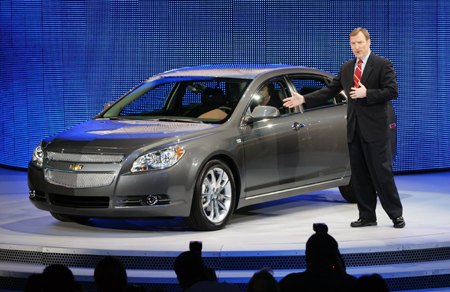General Motors Death Watch 141: False Dawn
In the second financial quarter, General Motors made $891m. The General's camp followers have been delighted with the slim not to say two percent profit. Meanwhile, GM North America (GMNA) lost $39m. The General has been almost universally commended for their U.S. division's performance, as it compares with a $3.95b loss in ’06. Supposedly, the move “close to profitability” indicates the rot has stopped, as a prelude to recovery. But lessening losses is not the same as making money, especially when you need money.
Make no mistake: GMNA needs LOTS of money. It needs tens of billions of dollars to eliminate the mountain of debt and obligations incurred in the downsizing process. Union buyouts, plant closures, ongoing payments to former parts maker Delphi, the upcoming Wall Street-requisite United Auto Workers pay-off– by the CFO's own admission, GM's cash conflagration is set to continue.
GMNA ain’t making it. Literally and figuratively. At best, GM CEO Rick Wagoner’s $9b in operational cuts have brought the automaker's U.S. expenditures in line with its reduced income. That’s fine, if you assume that income will increase from here on out and expenditure won’t. Both of which are false assumptions.
Next financial quarter, GMNA will shell-out $4b in capital expenditures. Annual plant closures and scheduled production cutbacks will also take their toll on their bottom line. More critically, if the two-month sales drop (July down 19%) is any indication, The General will continue to shed market share in a contracting market. Do the math. GMNA is about to make less money selling fewer vehicles.
After this false dawn, what then? Rabid Rick has two choices. He can slice more capacity from the system, continuing GM's death spiral. Or he can cut prices to move the moribund metal, further eroding his employer’s profit margins. Which are already crumbling under direct assault from Toyota and the transplants.
On Saturday, GM announced zero percent financing for up to 60 months on crew cab and extended cab Silverado pickup trucks. The move wipes some $2500 – $3000 off GM's pickup truck margins, halving their per truck profits. This after reigning-in Silverado production by 10 percent. Will there be another 'round of profit purloining discounts? Seems so.
Once again, still, GMNA’s future depends on selling a lot of something that makes a lot of money; something other than what they’re already trying to sell. Now that GM’s new pickup trucks have failed to generate the anticipated turnaround bucks, GMNA must pin its hopes on the new Pontiac G8, Cadillac CTS, Saturn Astra and Chevrolet Malibu.
The General is only planning on importing, at best, 30k to 50k Aussie-built G8s for beleaguered Pontiac/GMC/Buick dealers. Cadillac sold 24k lame duck CTS sedans this year (vs. 73k refreshed 3-Series). Even if Caddy's new, spizzarkle-prowed model doubles its current sales total, it won't be enough to keep GMNA afloat. The Saturn Astra arrives from Europe at a loss. Which leaves the hopes of a company resting squarely on the shoulders of the new Chevrolet Malibu.
So far this year, GM sold 60k Malibus (many discounted to fleets). In the same period, Toyota sold 212k Camrys and Honda flogged 180k Accords (hardly any of which sailed with the fleets). If GM thinks it’s going to slay the competition with the new Malibu– whose form and function are not a million miles away from the slow-selling Saturn Aura– it’s sorely mistaken. Even if the Malibu is significantly better than the Camry and Accord (also set for a refresh), conquest sales will be like pulling teeth. The demand for an Camcord alternative doesn’t exist.
All of which leaves GM where it is now: depending on sales abroad to generate enough cash for the corporate mothership to stay afloat. That said, while 58 percent of GM’s Q2 unit volume originated oversea, these sales only accounted for 38 percent of the company's total revenues. GMNA's recovery remains mission critical. Besides, what happens if GM’s foreign operations go sour? Amid all the jubilation over GM’s overseas success, there are signs of struggle and danger.
According to GM’s numbers, their Asia Pacific market share is decreasing in an expanding market. GM Brazil has hit a production capacity wall. Shanghai Automotive’s hook-up with countryman Nanjing Motors reaffirms suggestions that The People’s Republic of China wants the lion’s share of their domestic market for themselves. The currency situation is volatile. And last but not least, Toyota's lean, mean, lean production machine is beginning to turn its attention to these ripe pickings– which could turn moldy in an international economic downturn.
In short, GM’s overseas profits are not guaranteed; whereas ongoing and increasing U.S. losses are a sure bet. On balance, the automaker isn’t. Even if GM worldwide continues to deliver enough cash to subsidize GMNA, we’re heading towards the point where GM’s Board of Bystanders must contemplate declaring GMNA bankrupt to save the corporate mothership.
More by Robert Farago
Latest Car Reviews
Read moreLatest Product Reviews
Read moreRecent Comments
- Redapple2 I ve slept on it. I would take one on a 3 yr lease for $199/mo- ($1000 down total). Evil gm Vampire gave me this deal in 2012.
- 3SpeedAutomatic Would prefer a non-turbo with a stick shift. That would be more fun to drive!!🚗🚗🚗Also, I could teach my nieces and nephews to drive a standard. You'd be surprised how many folks can't handle a stick shift today. Yet, in Europe, most rental cars come with a stick unless you specify otherwise.
- Jeffrey Henry Ford said about innovation, “ If I had asked my customers what they wanted, then they would have said a faster horse." Change is inevitable!!!https://www.wri.org/insights/countries-adopting-electric-vehicles-fastest#:~:text=Currently%2C%2016%20countries%2C%20including%20Canada,create%20and%20enforce%20such%20policies.
- ToolGuy If these guys opened a hotel outside Cincinnati I would go there to sleep, and to dream.
- ToolGuy Michelin's price increases mean that my relationship with them as a customer is not sustainable. 🙁


































Comments
Join the conversation
I have to admit it's getting better It's getting better all the time Better, better, better It's getting better all the time Better, better, better http://images.google.com/imgres?imgurl=http://delivery.viewimages.com/xv/73963365.jpg%3Fv%3D1%26c%3DViewImages%26k%3D2%26d%3D17A4AD9FDB9CF1932BBB80AB57C9760238BAADA593B1271B8D27467263035E98&imgrefurl=http://www.viewimages.com/Search.aspx%3Fmid%3D73963365%26epmid%3D1%26partner%3DGoogle&h=297&w=198&sz=57&hl=en&start=1&um=1&tbnid=uo-Vhldus2HKFM:&tbnh=135&tbnw=90&prev=/images%3Fq%3Dclosed%2Bgm%2Bplant%26svnum%3D10%26um%3D1%26hl%3Den%26sa%3DG